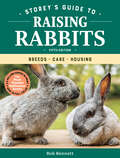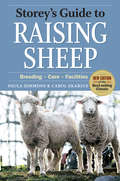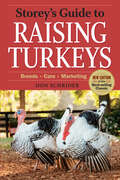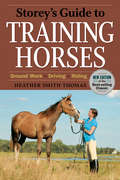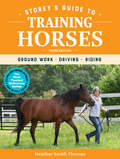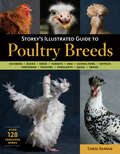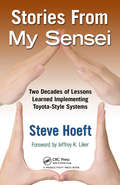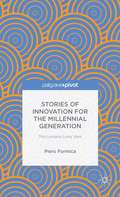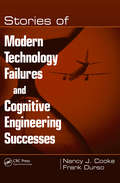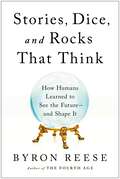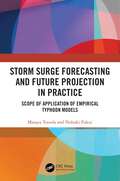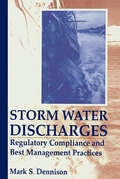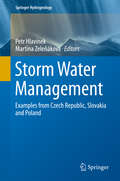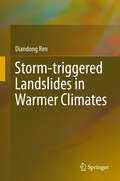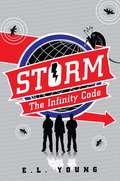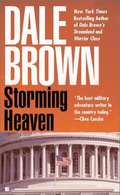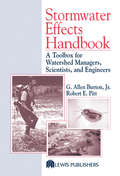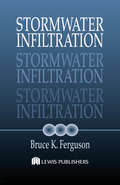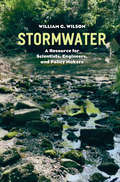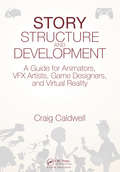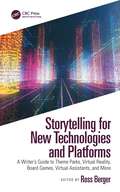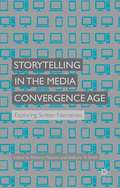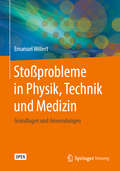- Table View
- List View
Storey's Guide to Raising Rabbits, 5th Edition: Breeds, Care, Housing (Storey’s Guide to Raising)
by Bob BennettThe fifth edition of this best-selling handbook features the same detailed approach that has made it the trusted source for raising healthy, productive rabbits — plus a total redesign with color photos and graphics. Whether you’re interested in raising rabbits for show, meat, fur, or as pets, this comprehensive guide offers expert advice on breed selection, housing, feeding, humane handling, and more. In addition, author Bob Bennett includes the most up-to-date information on preventive health care, treating diseases, marketing, and showing. This publication conforms to the EPUB Accessibility specification at WCAG 2.0 Level AA.
Storey's Guide to Raising Sheep, 4th Edition: Breeding, Care, Facilities (Storey’s Guide to Raising)
by Paula Simmons Carol EkariusDrawing from years of hands-on experience, Paula Simmons and Carol Ekarius provide expert advice on breed selection, lambing, feeding, housing, pasture maintenance, and medical care. You’ll also find tips on profitably marketing your meat and fiber products, as well as information on obtaining organic certifications.
Storey's Guide to Raising Sheep, 5th Edition: Breeding, Care, Facilities (Storey’s Guide to Raising)
by Paula Simmons Carol EkariusStorey’s Guide to Raising Sheep is the best-selling, most trusted reference for farmers and backyard homesteaders with any size flock. The fifth edition is now updated with full-color illustrations and photographs throughout, including a gallery of the best breed choices for both meat and fiber. With their small size and gentle dispositions, sheep are one of the easier livestock species to raise and offer varied marketing opportunities, including meat, wool, and milk. Detailed instructions and graphics lead readers through every essential procedure, including shearing, building a lambing shed, breeding and lambing, butchering, and marketing. This publication conforms to the EPUB Accessibility specification at WCAG 2.0 Level AA.
Storey's Guide to Raising Turkeys, 3rd Edition: Breeds, Care, Marketing (Storey’s Guide to Raising)
by Don SchriderTurkeys are an excellent source of succulent meat, rich eggs, and nutrient-dense manure, and raising them is a rewarding and profitable activity for many farmers. With helpful tips on acquiring organic certification, processing both meat and eggs, and marketing your products, you’ll have all the information you need to successfully raise your own healthy and productive turkeys.
Storey's Guide to Training Horses, 2nd Edition: Ground Work, Driving, Riding (Storey’s Guide to Raising)
by Heather Smith ThomasSafely and successfully train your own horse. Stressing the importance of understanding equine behavior, Storey’s Guide to Training Horses provides a series of progressive exercises that can easily be adjusted to suit your horse’s personality. Whether you’re raising an animal for farm work, competition, or show, you’ll learn everything you need to develop a well-trained and happy horse.
Storey's Guide to Training Horses, 3rd Edition: Ground Work, Driving, Riding (Storey’s Guide to Raising)
by Heather Smith ThomasStorey’s Guide to Training Horses is a one-stop reference for every aspect of horse training, including a complete program for turning a shy and gangly foal into a calm, confident, well-balanced equine partner. Now with full-color photography, the third edition includes step-by-step guidance on all the essential training procedures for both English- and Western-style riding, including haltering and leading, saddling and mounting, and addresses the finer points of gaits, lightness, and collection. Best-selling author Heather Smith Thomas draws on her decades of equestrian experience to anticipate every situation that might arise and provide answers to managing all the potential challenges of training different types of horses.
Storey's Illustrated Guide to Poultry Breeds: Chickens, Ducks, Geese, Turkeys, Emus, Guinea Fowl, Ostriches, Partridges, Peafowl, Pheasants, Quails, Swans
by Carol EkariusMore than 128 birds strut their stuff across the pages of this definitive primer for intrepid poultry farmers and feather fanciers alike. From the Manx Rumpy to the Redcap and the Ancona duck to his Aylesbury cousin, each breed is profiled with a brief history, detailed descriptions of identifying characteristics, and colorful photography. Comprehensive and fun, Storey’s Illustrated Guide to Poultry Breeds celebrates the personalities and charming good looks of North America’s quirkiest barnyard birds and waterfowl.
Stories from My Sensei: Two Decades of Lessons Learned Implementing Toyota-Style Systems
by Steve HoeftIn the tradition of Taoist philosophers and Zen masters, Steve Hoeft tells the stories he learned from his Toyota Production System (TPS) master teachers. Sometimes enigmatic, sometimes funny, but always powerful and enlightening, these stories of continuous improvement and Lean implementation are organized around the Toyota House framework. After
Stories of Innovation for the Millennial Generation: The Lynceus Long View
by Piero FormicaThe Lycneus's Longview uses the reality of fictional stories to help inspire the Millennial Generation.
Stories of Modern Technology Failures and Cognitive Engineering Successes
by Nancy J. Cooke Frank DursoA woman is operated on while she's awake...A plane runs out of gas while circling an airport for 30 minutes... A passenger liner is mistaken for an enemy fighter and shot down... A company invests in a new system that will cost them money... What do these failure have in common? How can we prevent them from happening again?
Stories, Dice, and Rocks That Think: How Humans Learned to See the Future--and Shape It
by Byron Reese"Byron Reese gets to the heart of what makes humans different from all others." —Midwest Book Review What makes the human mind so unique? And how did we get this way? This fascinating tale explores the three leaps in our history that made us what we are—and will change how you think about our future. Look around. Clearly, we humans are radically different from the other creatures on this planet. But why? Where are the Bronze Age beavers? The Iron Age iguanas? In Stories, Dice, and Rocks That Think, Byron Reese argues that we owe our special status to our ability to imagine the future and recall the past, escaping the perpetual present that all other living creatures are trapped in. Envisioning human history as the development of a societal superorganism he names Agora, Reese shows us how this escape enabled us to share knowledge on an unprecedented scale, and predict—and eventually master—the future. Thoughtful, witty, and compulsively readable, Reese unravels our history as an intelligent species in three acts: Act I: Ancient humans undergo &“the awakening,&” developing the cognitive ability to mentally time-travel using language Act II: In 17th century France, the mathematical framework known as 'probability theory' is born—a science for seeing into the future that we used to build the modern world Act III: Beginning with the invention of the computer chip, humanity creates machines to gaze into the future with even more precision, overcoming the limits of our brains A fresh new look at the history and destiny of humanity, readers will come away from Stories, Dice, and Rocks that Think with a new understanding of what they are—not just another animal, but a creature with a mastery of time itself.
Storm Surge Forecasting and Future Projection in Practice: Scope of Application of Empirical Typhoon Models
by Masaya Toyoda Nobuki FukuiThis accessible shortform book describes storm surge forecasting to enable port managers and practitioners to forecast these and mitigate their effects. This is particularly useful as global warming increases the severity of typhoons, particularly windstorms and storm surge disasters, globally.The authors first summarize the current status of typhoons and storm surges in practice. They also present a combination of the latest findings at the research level and at the practical level. Throughout the book, the authors carefully explain the use and limitations of empirical typhoon models that practitioners should learn from, including statistical, numerical, probabilistic, data-driven and coastal vulnerability models. They also explore artificial neural networks and convolutional neural networks and their use in such models. Finally, the book describes the potential for further development of empirical typhoon models (such as future climate experiments).This book is a vital resource that enables port managers to make effective and informed decisions when conducting storm surge forecasting in practice. It also contains useful insights for civil engineering students, especially those studying coastal engineering.
Storm Water Discharges: Regulatory Compliance and Best Management Practices
by Mark S. DennisonFilled with tables, checklists, worksheets, and sample plans, Storm Water Discharges is a unique, nontechnical guide to the full spectrum of storm water issues. Written in a language accessible to everyone, this guide offers a practical, nuts-and-bolts approach to compliance with EPA's complex storm water discharge requirements. In addition to a st
Storm Water Management
by Petr Hlavínek Martina ZeleňákováThis book reviews the current state of the art in managing infrastructure, urban regions, industrial regions and inhabited areas with respect to flooding and water damage. The author is a well-known expert in storm water management, and this book gives a broad overview of the different manageable components that play a role in storm water risks. It includes chapters on planning infrastructure and regional development, modifications in urban regions and localities with buildings and historical buildings, covering different city types and residential areas, housing and commercial zones, as well as housing development. The author then goes on to review different hydrological conditions that make areas safer, or more prone to storm water threats, and capture and store storm water. The last part of the books covers sealed infrastructure and their role in storm water hazards, including roads, public spaces, roofs, and others.
Storm-triggered Landslides in Warmer Climates
by Diandong RenThis volume discusses the general physics of debris flows and various approaches to modeling - including the SEGMENT-Landslide approach - as well as the pros and cons of these approaches and how other approaches are sub-sets of the SEGMENT-Landslide approach. In addition, this volume will systematically unify the concepts of vadose zone hydrology and geotechnical engineering, with special emphasis on quantifying ecosystem consequences of storm-triggered landslides in a warmer climate setting. The reader will find a comprehensive coverage of concepts ranging from hillslope hydrology, porous granular material rheology and the fundamentals of soil properties, to state-of-the-art concepts of enhanced hydrological cycle with climate warming and a discussion of new approaches for future research.
Storm: The Infinity Code
by E. L. YoungSTORM is a gadget-packed, high-adrenaline adventure-and also the name of a dynamic organization formed by three brainiac kids: WILL: loner, inventive genius, and creator of cutting-edge gear- STORM'S resident skeptic ANDREW: software whiz-kid and millionaire-STORM's founder, financial backer, and fashion disaster GAIA: brilliant and mysterious chemist-fluent in French, Italian, Mandarin, and blowing stuff up AT FIRST, Will scoffs at STORM's grand plans to combat global strife. But when the group uncovers a plot to create a deadly, revolutionary weapon, Will is forced to swallow his doubts-and fast. He, Gaia, and Andrew must race from London to St. Petersburg to find and dismantle the weapon, and confront the psychopathic scientist behind it all. But there's more to this wicked plot than meets the eye. Whether STORM is up to the task or not, one thing's for sure-their lives are never going to be the same.
Storming Heaven (Independent #4)
by Dale BrownAbused by American soldiers during an incarceration in Europe, Henri Cazaux has waited years to exact revenge on the U.S. He uses commercial aircraft to deploy bombs on major U.S. airports--killing thousands, halting air traffic, and creating national panic. Rear Admiral Ian Hardcastle and It. Col. Al Vincenti are ordered to reestablish security in the skies.
Stormwater Effects Handbook: A Toolbox for Watershed Managers, Scientists, and Engineers
by G. Allen Burton Jr. Robert PittA stand-alone working document, Stormwater Effects Handbook: A Toolbox for Watershed Managers, Scientists, and Engineers assists scientists and regulators in determining when stormwater runoff causes adverse effects in receiving waters. This complicated task requires an integrated assessment approach that focuses on sampling before, during, and aft
Stormwater Infiltration
by Bruce K. FergusonStormwater infiltration is the most complete approach to stormwater management. Only infiltration can simultaneously solve problems of water quality, flood control, streambank erosion, aquifer recharge, and maintenance of downstream base flows and wetland hydroperiods. Stormwater Infiltration is the first book to explain the principles of natural science on which infiltration is based, how to apply infiltration to any region of the country, and what kinds of results can be expected. It brings into one publication the complete range of necessary information on soils, vegetation, infiltration, hydrology, design criteria, site layout, construction process for surface and subsurface basins, porous paving materials, feasibility, maintenance, and performance. It draws more than half a century's actual experiences from all over the United States to place stormwater management in a context of environmental balance and quality for human life.
Stormwater: A Resource for Scientists, Engineers, and Policy Makers
by William G. WilsonAs cities grow and climates change, precipitation increases, and with every great storm—from record-breaking Boston blizzards to floods in Houston—come buckets of stormwater and a deluge of problems. In Stormwater, William G. Wilson brings us the first expansive guide to stormwater science and management in urban environments, where rising runoff threatens both human and environmental health. As Wilson shows, rivers of runoff flowing from manmade surfaces—such as roads, sidewalks, and industrial sites—carry a glut of sediments and pollutants. Unlike soil, pavement does not filter or biodegrade these contaminants. Oil, pesticides, road salts, metals, automobile chemicals, and bacteria all pour into stormwater systems. Often this runoff discharges directly into waterways, uncontrolled and untreated, damaging valuable ecosystems. Detailing the harm that can be caused by this urban runoff, Wilson also outlines methods of control, from restored watersheds to green roofs and rain gardens, and, in so doing, gives hope in the face of an omnipresent threat. Illustrated throughout, Stormwater will be an essential resource for urban planners and scientists, policy makers, citizen activists, and environmental educators in the stormy decades to come.
Story Structure and Development: A Guide for Animators, VFX Artists, Game Designers, and Virtual Reality
by Craig CaldwellProfessor Craig Caldwell’s Story Structure and Development offers a clear approach to the essentials of story. It lays out the fundamental elements, principles, and structure for animators, designers, and artists so they can incorporate these concepts in their work. As a practical guide it includes extensive insights and advice from industry professionals. Readers will learn the universal patterns of story and narrative used in today’s movies, animation, games, and VR. With over 200 colorful images, this book has been designed for visual learners, and is organized to provide access to story concepts for the screen media professional and student. Readers will discover the story fundamentals referred to by every director and producer when they say "It’s all about story".
Storytelling for New Technologies and Platforms: A Writer’s Guide to Theme Parks, Virtual Reality, Board Games, Virtual Assistants, and More
by Ross BergerWant to know what it’s like to write for a theme park attraction? Or an interactive toy? Or for a virtual reality game? Wait – those tell stories? And there are jobs for people to write them? Thanks to technology, interactive products and live experiences can now engage us with memorable characters and exciting adventures that were once only destined for the cinema. Storytelling for New Technologies and Platforms: A Writer’s Guide to Theme Parks, Virtual Reality, Board Games, Virtual Assistants, and More is a handbook for writers, students, producers, teachers, scholars, career changers, early tech adopters, and just about anyone who loves story and technology. As a collection of articles from some of the best creative writers in their medium, this book will prepare content creators of tomorrow to tackle some of today's most exhilarating creative challenges found on a screen ... or off! Key Features: Expert advice from several industry professionals who have worked for some of the world’s biggest tech and interactive companies. Best practices that not only guide writers on how to apply their craft to new fields, but also prepare them for the common ambiguity they will find in corporate and start-up environments. Breakdown of platforms that shows how tech capabilities can fulfill content expectations and how content can fulfill tech expectations. Basic storytelling mechanics customized to today’s popular technologies, live experiences, and traditional game platforms.
Storytelling in the Media Convergence Age
by Roberta Pearson Anthony N. SmithThis collection investigates the relationship between contemporary screen narratives and their varied contexts of production, circulation and reception, exploring storytelling practices across a range of different media and national and institutional sites. While convergence and globalisation blur the boundaries between media and nations, it is still vital to account for the persistent national, medium, institutional and technological specificities that give rise to different narrative forms. The chapters study the ways in which these factors shape events, characters and settings; inform modes of narrative presentation; influence, via paratextual surround, potential interpretations; and accord certain stories more value than others. The authors use case studies drawn from a range of media, from Hollywood franchises to digital comics, and a range of countries, from United States to Japan. In connecting contemporary screen media narratives to their contexts, this book offers a new perspective on recent transformations in screen media culture.
Stowaway to the Mushroom Planet
by Eleanor CameronDoes anyone but Chuck Masterson and David Topman and Mr. Bass know about the Mushroom Planet? Well, there's Mr. Tyco Bass's cousin, Mr. Theo. He is a Mushroom Person, like Mr. Tyco, so he knows. And of course David and Chuck told their families about THE WONDERFUL FLIGHT TO THE MUSHROOM PLANET (along with a good many thousands of readers). But what if just an ordinary human being should happen to find out about it? Would it ruin everything? The answer is in this second story about Basidium, the small planet which can only be seen when Tyco Bass's special filter is affixed to the telescope. David and Chuck, returning to Basidium in their new space ship, have considerable difficulty carrying out Mr. Bass's wish that the planet be kept a dead secret. One Horatio Q. Peabody makes this trip even more of an adventure than the first one.
Stoßprobleme in Physik, Technik und Medizin: Grundlagen und Anwendungen
by Emanuel WillertDieses Open Access Buch widmet sich dem Problem der Mechanik des Zusammenstoßes zweier makroskopischer Körper. Falls die Dynamik der Körper als Ganzes dies erlaubt, ohne in unüberschaubare Komplexität zu verfallen (in der Regel ist das nur für das reine Normalstoßproblem der Fall), werden allgemeine axialsymmetrische Stoßpartner betrachtet. Für das allgemeine räumliche Stoßproblem wird sich auf den Kontakt von Kugeln beschränkt. Zunächst werden im Buch sehr ausführlich die kontaktmechanischen Grundlagen (Elastizität, Plastizität, Viskoelastizität, Adhäsion, Gradientenmedien) dargestellt und anschließend auf das Stoßproblem übertragen. Mit der Methode der Dimensionsreduktion, der ein eigenes Kapitel gewidmet ist, steht außerdem seit wenigen Jahren ein Werkzeug zu Verfügung, das die sehr effiziente analytische und numerische Behandlung von dynamischen Kontaktproblemen (wie z.B. Stößen) ermöglicht.Den Abschluss des Buch bilden Anwendungsfälle aus verschiedenen Gebieten.
